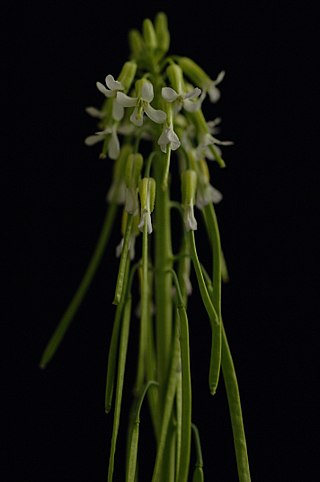Related Research Articles

Arabidopsis (rockcress) is a genus in the family Brassicaceae. They are small flowering plants related to cabbage and mustard. This genus is of great interest since it contains thale cress, one of the model organisms used for studying plant biology and the first plant to have its entire genome sequenced. Changes in thale cress are easily observed, making it a very useful model.

Nasturtium is a genus of a small number of plant species in the family Brassicaceae commonly known as watercress or yellowcress. The best known species are the edible Nasturtium officinale and Nasturtium microphyllum. Nasturtium was previously synonymised with Rorippa, but molecular evidence supports its maintenance as a distinct genus more closely related to Cardamine than to Rorippasensu stricto.

Peter Hamilton Raven is an American botanist and environmentalist, notable as the longtime director, now President Emeritus, of the Missouri Botanical Garden.

Arabis, or rockcress, is a genus of flowering plants, within the family Brassicaceae.

Boechera (rockcress) is a genus of the family Brassicaceae. It was named after the Danish botanist Tyge W. Böcher (1909–1983), who was known for his research in alpine plants, including the mustards Draba and Boechera holboellii. According to recent molecular-based studies, Boechera is closely related to the genus Arabidopsis which also includes the widely known model plant Arabidopsis thaliana.

Draba is a large genus of flowering plants in the family Brassicaceae, commonly known as whitlow-grasses.

Heliophila is a genus of flowering plants in the family Brassicaceae. Members of this genus are either annuals or perennials and some are popular as ornamental plants. Endemic to southern Africa, the majority of the approximately 80 species grow in South Africa, particularly the Cape Floristic Region, while a few extend into the Namib Desert.

Draba verna, common whitlowgrass, is a species of plant in the cabbage family. It is a small spring-flowering annual which is widely dispersed around the world, and which is found on walls, pavements and patches of bare ground. It has a complex taxonomy which is not yet fully elucidated.

Boechera holboellii, or Holbøll's rockcress, is a species of plant in the family Brassicaceae. Its cytology has been much studied by the Danish botanist Tyge W. Böcher. Circumscription of this species has varied, with earlier works treating it as a widespread, polymorphic species with several varieties, while more recently it has been treated as a much more narrowly defined species from Greenland.

Peltaria is a genus of flowering plants in the family Brassicaceae. Their distribution ranges from Southeast Europe, Near East to Central Asia. They prefer rocky slopes.
Graellsia is a genus of small perennial sub-caespitose herbs in the family Brassicaceae. Most of the species are found in Iran and Afghanistan, with one occurring in Turkey, and one in the High Atlas of Morocco. They are typically found in shady crevices of calcareous rocks at altitudes of 1,000–3,600 metres (3,300–11,800 ft).
Petroravenia is a genus of plants in the family Brassicaceae, first described in 1994. There are to date only two species proposed as members of the genus:
Arabidopsis arenicola, the Arctic rock-cress, is a plant species native to the northeastern part of North America. It has been reported from Greenland, Labrador, Nunavut, Northwest Territories, Québec, Ontario, Manitoba, and Saskatchewan. It grows on sandy or gravely beaches or stream banks at elevations below 1,500 metres (4,900 ft).
Boechera tularensis, common name Tulare rockcress, is a plant species endemic to California. It has been reported from Inyo, Mono, Tulare, Fresno, Madera, El Dorado and Mariposa Counties. It grows on rocky slopes in subalpine habitats at elevations of 2400–3200 m.

Dr. Charlotte M. Taylor is a botanist and professor specialising in taxonomy and conservation. She works with the large plant family Rubiaceae, particularly found in the American tropics and in the tribes Palicoureeae and Psychotrieae. This plant family is an economically important group, as it includes plant species used to make coffee and quinine. Taylor also conducts work related to the floristics of Rubiaceae and morphological radiations of the group. Taylor has collected plant samples from many countries across the globe, including Chile, Colombia, Costa Rica, Panama, and the United States of America, and has named many new species known to science from these regions. As of 2023, Taylor has authored 500 land plant species' names, the third-highest number of such names authored by any female scientist.
Chilocardamum is a small genus of four herbaceous cress-like species of plants in the family Brassicaceae, only found growing in Patagonia, southern Argentina.

Polypsecadium is a genus of large herbaceous species of plants in the family Brassicaceae, found growing in South America. Most of the species were formerly classified in the genus Sisymbrium.
Parlatoria is a monotypic genus of flowering plants belonging to the family Brassicaceae. It just contains one species, Parlatoria cakiloideaBoiss.
Cardamine dissecta is a species of flowering plant in the mustard family Brassicaceae.
References
- 1 2 3 4 5 2008 Missouri Botanical Garden
- ↑ The Durango Herald "Botanists discover 2 plant species (March 6, 2008)
- ↑ U.S. Fish and Wildlife Service: Missouri Bladderpod 5-Year Review (2008)
- ↑ Author attributions for Southern California plant names
- 1 2 Biography at efloras.org
- 1 2 3 Flora of China Project (harvard.edu)
- 1 2 3 4 5 6 7 MBG Research: The Unseen Garden
- 1 2 Archived 2011-05-24 at the Wayback Machine Flora of North America (harvard.edu)
- ↑ International Plant Names Index. Al-Shehbaz.